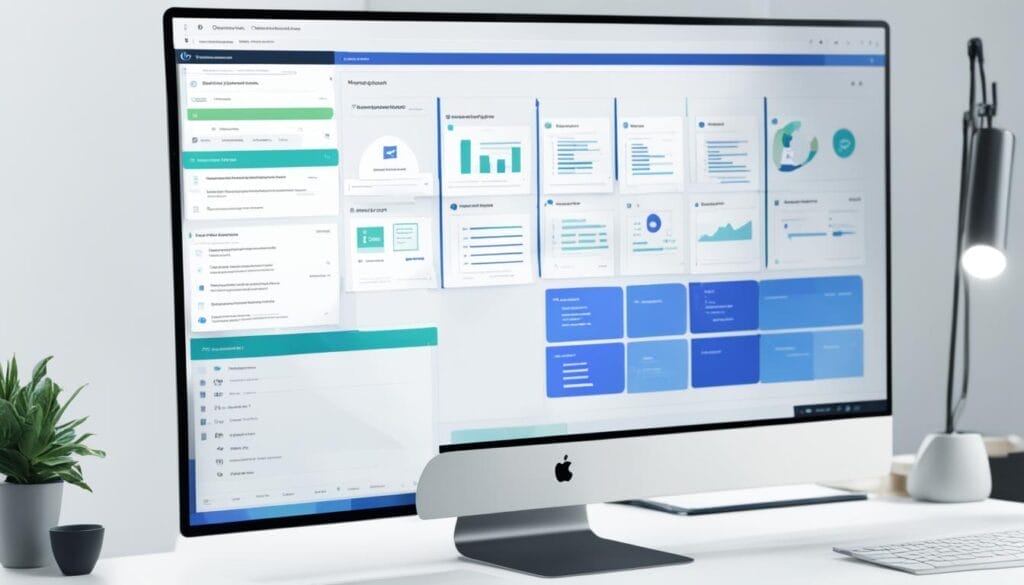Content management is key for a strong online presence today. As the world moves more online, everyone is looking for digital content. Good content management strategies have become very important.
It’s all about making, putting things in order, and sharing online content. This content is then given to the people who want it at the right moment. Using the right tools and plans, both companies and people can make their content work better. They can be seen more online and really grab their audience’s attention.
No matter if you’re running a small business, writing a blog, or making online stuff, content management skills are vital. In this article, we’ll dive into essential content management tips. This includes making digital content, managing your website, planning your content, being smart about SEO, looking after your data, and setting up a content calendar. By using these strategies, your online presence can really go up.
Key Takeaways:
- Content management is essential for establishing and maintaining an online presence.
- A content management system (CMS) simplifies content creation, editing and publishing.
- Effective content management strategies enhance online visibility and engagement.
- Content strategy, SEO optimisation, and data management are integral to successful content management.
- Proper content scheduling ensures consistent and timely delivery of digital content.
Understanding the Importance of Content Management
Content management is crucial for a solid online presence today. A content management system (CMS) helps a lot. It simplifies how we handle website content without needing to code.
A CMS makes managing lots of info easier. It keeps everything on the website consistent and accurate. This makes user experience better and boosts the brand online.
Collaborating on content is simpler with a CMS. It lets many people work together easily. This is great for teams in different places, making work more efficient.
Keeping website content updated is easy with a CMS. In the fast digital world, staying current is key to keep your audience interested. A CMS saves a lot of time and helps keep content fresh.
Good website content is vital in the digital world. It attracts visitors, informs them, and encourages actions. Great content, whether blogs or product descriptions, builds trust and a strong online presence.
For businesses and people to succeed online, content management is key. With a simple CMS, managing content is not a hassle. This lets you focus on creating valuable and engaging content for your audience.
Types of Content Management Systems
Content management has different systems to meet various needs. Two common ones are traditional CMS and cloud-based CMS. Let’s look at each of them.
Traditional CMS
This kind of CMS needs to be installed and looked after on a server. It lets you adjust your site to match exactly what you need. Those who are good with tech will love this option.
But, using a traditional CMS means you must know some technical things. Setting it up, keeping it going, and making it perfect can be a lot of work. So, only choose this if you really like customising and have the tech skills for it.
Cloud-based CMS
A cloud-based CMS is easy because you don’t need to deal with server stuff. It lives on the internet, which means you can get to it from any computer online. This “in-the-cloud” setup is great for people starting out or who don’t know much about tech.
Because it’s in the cloud, you also don’t have to fuss over the techy bits. The platform is set up to be simple, letting you focus just on your content. But, it might not let you customise as much as a traditional CMS would.
In short, traditional CMS gives you loads of freedom to customise but asks for tech knowledge. In contrast, cloud-based CMS is straightforward and doesn’t need you to be a tech wizard. Your choice depends on what you need and what you like.

| Traditional CMS | Cloud-based CMS |
|---|---|
| Requires installation and maintenance on a server | Hosted in the cloud, no server setup or maintenance required |
| Offers more flexibility and customisation options | User-friendly and hassle-free experience |
| Requires technical knowledge to set up and manage | No technical expertise needed |
| Full control over design and functionality | Limited customisation options |
Benefits of Using a Content Management System
A content management system (CMS) is great for both people and companies. It’s made to be easy to use. This means anyone can make and look after content without needing to be a tech expert. This saves time and money that you might spend on hiring website developers or designers.
One big plus of CMS platforms is how they let you make your site yours. You can change how your website looks and works to match what you need. By choosing from lots of design and layout options, you can make an online space that really shows off your brand.
On CMS platforms, working together is simple. They have features for collaboration and workflow management. This means lots of people can join in making and managing content. It helps everyone work better together and keep up to date.
Search engine optimisation (SEO) comes built into CMS platforms too. This helps your website get seen more in search results. Features like making your website’s information clearer to search engines and coming up with easy-to-understand web addresses can boost how well your site does in searches.
“Using a CMS is a game-changer for managing digital content. It combines ease of use, time and cost efficiency, customisation, flexibility, collaboration, and workflow management to streamline content creation and management.” – Paul Nightingale, Digital Marketer
Having a CMS means you’re in charge of everything on your website. Keeping it up to date is easy, helping you stand out online. Thanks to its many features, it’s clear why CMS platforms are the top pick for looking after content today.
CMS Platform Comparison
| CMS Platform | Ease of Use | Customization Options | Flexibility | Community Support |
|---|---|---|---|---|
| WordPress | High | Extensive | High | Active community |
| Drupal | Intermediate | High | High | Strong community |
| Joomla | High | Extensive | Intermediate | Supportive community |
Popular Content Management Systems
Choosing a content management system (CMS) means looking at popular options like WordPress, Drupal, and Joomla. Each has its unique features. Let’s explore these three.
WordPress
WordPress is the most used CMS. It’s easy for anyone to use, even without coding skills. You can make your site look just how you want with its plugins. WordPress has a big community. This means lots of help is available.
Drupal
Drupal is known for being tough and secure. It’s often used by big groups and governments. It’s harder to learn than WordPress but offers more options. Drupal lets you do a lot once you know how.
Joomla
Joomla is easy and flexible. It’s good for many types of sites. You can start quickly, and there’s lots of help around. Joomla is also known for its community support.

| Feature | WordPress | Drupal | Joomla |
|---|---|---|---|
| User-Friendly Interface | Yes | No | Yes |
| Extensive Plugin Library | Yes | Yes | No |
| Customization Options | Yes | Yes | Yes |
| Flexibility | High | High | High |
| Community Support | Strong | Moderate | Strong |
Each CMS in the table has its benefits. WordPress is great for its friendly setup and many plugins. Drupal suits big jobs needing to grow, with advanced safety. Joomla is a middle ground. It’s easy but also versatile and has good community help.
Which CMS to choose depends on what you need and how much you know. Knowing what each does best helps pick the right one for you.
Choosing the Right CMS for Your Website
Choosing the best content management system (CMS) for your website is key. It makes managing your content smoother and more efficient. Success comes from looking at several factors that affect your CMS choice.
- Ease of Use: Find a CMS that is easy to use, saving you time and hassle.
- Customisation Options: Pick a CMS that lets you change your site to suit your brand. This ensures a unique experience for visitors.
- Scalability: Think about your site’s future growth and pick a CMS that can handle more visitors and content without lagging.
- Community Support: Choose a CMS with a helpful user community. They offer resources and advice when you need help.
- Security: The security of your site is critical. Go for a CMS with strong security measures to keep your content and data safe.
After choosing a CMS, setting it up involves important steps. First, choose a good host that meets your site’s needs. Think about server resources and security.
Next, install your CMS on the hosting you picked. The installation guide is usually clear and easy to follow.
Then, make your site look and work the way you want. Choose a theme or template, add plugins, and customise your design.
Setting up user roles and permissions is also crucial. This lets you control who can do what on your site, keeping it secure.
Finally, add or create the content you need. You might move over old content or start fresh, depending on what you want.

| Factors to Consider | Description |
|---|---|
| Ease of Use | Look for a CMS with an intuitive interface |
| Customisation Options | Choose a CMS that allows for personalised website experiences |
| Scalability | Select a CMS that can handle future growth and increasing traffic |
| Community Support | Opt for a CMS with an active community for assistance and resources |
| Security | Prioritise a CMS that provides robust security measures |
Best Practices for Content Management
To manage content well with a content management system (CMS), you should follow some top practices. These tips help keep your content strategy strong and your material engaging.
- Make a content calendar for your content plans. It lets you organize and plan your creation, keeping your content fresh.
- Use metadata to add info about your content, like a title and keywords. This helps search engines find your content better.
- Have version control to track changes in your content. It ensures everyone sees the latest version, avoiding old info.
- Make sure your content is easy to find and understand. This means making it work well on all devices and for everyone, including those who use special tools to access the web.
- Stick to a clear content management process. It’s a set way to create, organise, and oversee your content. This keeps everything running smoothly.
Following these best practices helps content managers work more efficiently. They can make their content better and easier to access. Plus, it paves the way for a strong content management system on their site.
Example of a Content Calendar
| Date | Content Topic | Assigned To |
|---|---|---|
| 1st May | New Product Launch | Marketing Team |
| 8th May | Customer Success Story | Content Writer |
| 15th May | Industry Expert Interview | Content Writer |
A content calendar lets teams plan their content ahead, keeping a regular flow. This approach helps meet content goals and resonate with the audience.

Using a content calendar, metadata, version control, and more are key for an efficient content management process online. They help in keeping up a good online presence.
My Conclusion
Knowing how to manage your online content well is crucial for a strong digital presence. This applies to both businesses and individuals. Using a content management system (CMS) helps in many ways. It lets you create, manage, and improve your digital content. By using the right strategies and tools, you can make the process smoother and better.
These steps help make sure your online content is excellent. They also allow your online platform to reach its full potential. Managing your content well lets you connect with your audience better. You can draw more visitors and make sure your message is seen clearly.
If you’re looking for an all-in-one marketing solution, try Convertrr marketing software.
It’s worth the time to get good at content management. Staying on top of the latest trends keeps you in front. Good content management isn’t just about writing and posting things. It’s about having a clear plan that shows off your brand and captures the interest of your audience.
FAQ
What is content management?
Content management means creating, editing, and adding digital content to a website. This is done without needing deep technical skills.
Why is content management important?
In today’s digital world, content management is key to having an online space. It makes updating content easy, keeping your website fresh and relevant.
What are the types of content management systems?
You’ll find traditional CMS needing a server for installation and maintenance. There are also cloud-based options. These are held virtually and don’t require server setup or care.
What are the benefits of using a content management system?
These systems make things easier and save time and money. You can customise and manage work with others easily. They also help to improve your website’s visibility on search engines.
What are some popular content management systems?
WordPress, Drupal, and Joomla are well-known for their simple designs and helpful add-ons. They have a big community that can give you advice and support.
How do I choose the right CMS for my website?
Think about what you need in terms of ease of use, growth potential, and safety. Consider how strong the community around the CMS is. This will help you decide.
What are best practices for content management?
It’s smart to make a content plan and use metadata well. Keep track of changes with version control. Make sure your content is easy to find and follows a clear process.
Why is mastering content management strategies important?
Knowing how to manage content well helps keep up your online image. It makes sure your content is great for the digital world and really connects with people.
Source Links
READY TO TAKE BACK CONTROL?
- GET FOUND ONLINE
- GENERATE NEW LEADS
- WIN MORE SALES






